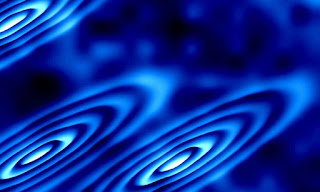 |
| Strange electron orbits form on the surface of a crystal in this image created using a theoretical data model. These orbits correspond to the electrons being in different 'valleys' of states, yielding new insights into an area of research called 'vallytronics,' which seeks alternative ways to manipulate electrons for future electronic applications. Credit: Ali Yazdani, Department of Physics, Princeton University |
Topics: Materials Science, Moore's Law, Nanotechnology, Quantum Mechanics, Semiconductor Technology
For the first time, an experiment has directly imaged electron orbits in a high-magnetic field, illuminating an unusual collective behavior in electrons and suggesting new ways of manipulating the charged particles.
The study, conducted by researchers at Princeton University and the University of Texas-Austin was published Oct. 21, in the journal Science. The study demonstrates that the electrons, when kept at very low temperatures where their quantum behaviors emerge, can spontaneously begin to travel in identical elliptical paths on the surface of a crystal of bismuth, forming a quantum fluid state. This behavior was anticipated theoretically during the past two decades by researchers from Princeton and other universities.
"This is the first visualization of a quantum fluid of electrons in which interactions between the electrons make them collectively choose orbits with these unusual shapes," said Ali Yazdani, the Class of 1909 Professor of Physics at Princeton, who led the research.
"The other big finding is that this is the first time the orbits of electrons moving in a magnetic field have been directly visualized," Yazdani said. "In fact, it is our ability to image these orbits that allowed us to detect the formation of this strange quantum liquid."
Fundamental explorations of materials may provide the basis for faster and more efficient electronic technologies. Today's electronic devices, from computers to cellphones, use processors made from silicon. With silicon reaching its maximum capacity for information processing, researchers are looking to other materials and mechanisms.
One area of progress has been in two-dimensional materials, which allow control of electron motion by breaking the particles away from the constraints of the underlying crystal lattice. This involves moving electrons among "pockets" or "valleys" of possible states created by the crystal. Some researchers are working on ways to apply this process in an emerging field of research known as "valleytronics."
Phys.org: Unusual quantum liquid on crystal surface could inspire future electronics
Comments